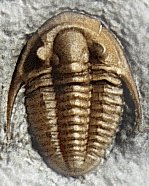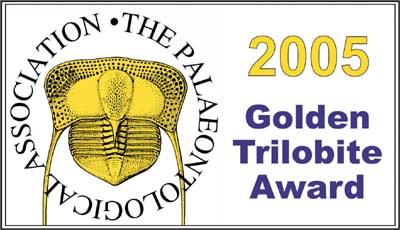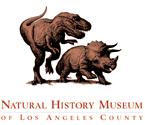-Menu
--
Introduction
Glossary of terms
Geological Time
Major Features
Site Map
Morphology:
Dorsal Morphology
Ventral Morphology
Internal Anatomy
Major Features
Facial Sutures
Hypostome
Cephalon
Thorax
Pygidium
Special Terms
Trilobite Eyes
Prosopon
Abnormalities
Glossary of terms
Classification:
Arthropods
Trilobite Origins
Trilobite Orders
Key to the Orders
Evolutionary trends
Pictorial Guides
Trilobite Families
Trilobite Genera
ICZN Business
Paleobiology:
Ecology
Trace Fossils
Feeding Habits
Paleogeography
Biostratigraphy
Trilobite Localities
Reproduction
Ontogeny
Molting
Enrollment
Extinction
Miscellaneous:
Trilobite FAQ
Trilobite Quiz
Trilobite Links
Trilobite Photos
Trilobite.Preparation
Drawing Trilobites
Trilobite.Imposters
Selected References
Trilobite books
Trilobite folio
Site Accolades
...
Thank you!
Many thanks to:
Aaron Miller
for graciously hosting the www.trilobites.info domain since
April 2008
A website devoted to understanding trilobites
created and maintained by Sam Gon III
|
walking
trilobite
©2000
This image anywhere on this site goes to the main menu |
SEARCH THIS WEBSITE

.
Postikaolishania jingxiensis Zhu 2005
Sandu Fm., U. Cambrian, Furongian Ser.
Jingxi, Guole Cty., Guangxi Prov., China
From
2019 forward, the Trilobite
of the Month will be posted in the
Trilobites
Group on Facebook. Look for detailed
descriptions of these showcased trilobites at the
start of each month. I
end the monthly updates here with one of my favorites from
the archives of nearly a decade of TOMs: Postikaolishania
jingxiensis from China, a ceratopygid
member of Order Asaphida,
from the Furongian Series (Late
Cambrian). I love its classic trilobite look, sharp
pleural spines, graceful head shield, well-developed eyes,
and the clearly differentiated central and paired lateral
lobes that define "trilobite."
Images like this help explain why trilobites are one of the best-known and appreciated groups of prehistoric animals. Each month, a new example of trilobite diversity will be showcased here. With over 20,000 described species, we may never exhaust the possibilities! If you have a stunning image of a trilobite that you could share as a future "Trilobite of the Month," please let me know!

|
Trilobites are the most diverse group of extinct animals preserved in the fossil record. Ten orders of trilobites are recognized, into which 20,000+ species are placed. Learn more about trilobite morphology, anatomy, ecology, behavior, reproduction, and development, and how they relate to trilobite origins, evolution, and classification. Explore trilobite biostratigraphy, paleobiogeography, persistence across geological time, and their ultimate extinction. View galleries of trilobite images from the web, examine fact sheets, pictorial guides, and an identification key for each order, refer to a family listing, a genus listing, or consult a trilobite glossary and bibliography, tour world famous trilobite localities, explore links to other web resources on trilobites, and review books on trilobites, including an exclusive hardcopy pictorial adaptation of this website. |
| Maurotarion christyi via Marc Behrendt. |
Sheets










This site has enjoyed feedback from a growing number of trilobite workers from all over the world who have
generously offered their suggestions and corrections. I gratefully acknowledge their help and encouragement.
This website protected by copyright ©1999 - 2018 by S. M. Gon III
The Trilobite FAQ
Use the links on the right to answer the Qs on the left
| Unfamiliar with trilobites altogether? | Introduction to Trilobites | ||
| What are trilobite body parts called? | Trilobite Dorsal Morphology | ||
| Unfamiliar with trilobite undersides? | Trilobite Ventral Morphology | ||
| What about the inside of a trilobite? | Trilobite Internal Anatomy | ||
| What was special about trilobite eyes? | Trilobite Eyes & Vision | ||
| Want definitions of trilobite terms? | Glossary of Trilobite Terms | ||
| How are the trilobite orders related? | Trilobite Systematic Relationships | ||
| Want a list of all trilobite families? | Phylogenetic List of Trilobite Families | ||
| Want a list of all trilobite genera? | List of 5000 Trilobite Generic Names | ||
| How long ago did trilobites exist? | Geological Time relevant to Trilobites | ||
| Can trilobites help determine geological time? | Trilobite Biostratigraphy | ||
| What ecological roles did trilobites play? | Trilobite Ecology and Environments | ||
| How do we know about trilobite behavior? | Trilobite Trace Fossils | ||
| What and how did trilobites eat? | Trilobite Feeding Habits | ||
| How did trilobites reproduce and grow? | Trilobite Reproduction & Development | ||
| What roles did sutures play in molting? | Trilobite Sutures & Molting | ||
| What about trilobite bumps and spines? | Trilobite Prosopon | ||
| How did trilobites defend themselves? | Trilobite Enrollment & Coaptation | ||
| How did trilobites evolve? | Trilobite Evolutionary Trends | ||
| What is the origin of trilobites? | Trilobites Origins | ||
| What were the first trilobites? | The First Trilobites | ||
| What
were the last trilobites? |
Trilobite
Extinction |
||
| Did
trilobites show any signs of disease? |
Trilobite
Abnormalities |
||
| Didn't I see a living trilobite? | Trilobite Imposters | ||
| Where
in the world are trilobites found now? |
World
Trilobite Localities |
||
| How did the Earth look when trilobites lived? | Trilobite Paleogeography | ||
| Think you know about trilobites now? | Take the Trilobite Identification Quiz! | ||
| How big did trilobites get? | World's Largest Trilobites | ||
| How do you prepare a trilobite fossil? | Trilobite Preparation | ||
| Is this site available in hardcopy form? | Yes! Preview the folio pages here | ||
| Are there many books on trilobites? | Review recommended trilobite books! | ||
| Found mistakes or refinements needed? | Please tell me about them |
SEARCH THIS WEBSITE THIS SITE OPTIMIZED FOR VIEWING AT 1024 X 768 RESOLUTION
In these pages, you may recognize species that are common, well-known, or sitting in a familiar museum collection!
This guide might help you arrange trilobite diversity systematically, aid in identification of specimens, and enhance your understanding of these fascinating elements of Paleozoic biodiversity. Happy browsing! -- Sam Gon III


































